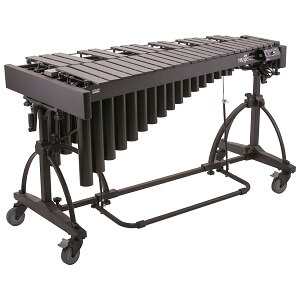Vibraphone
 The vibraphone is a metallophone idiophone of American origin. It is today found distributed throughout the world wherever Western cosmopolitanism has taken root. It is commonly found in jazz bands and combos (see Jazz Combo), in percussion ensembles (see Keyboard Percussion Ensembles and Mixed Percussion Ensembles), and is called for occasionally in orchestral and concert band works. The vibraphone, like other keyboard percussion instruments, necessitates a level of specialization on the part of the performer to play well, and not every percussionist can be expected to be proficient on it. In the jazz idiom, a few players in particular have elevated the vibraphone to the status of a solo instrument (listen to the audio clip).
The vibraphone is a metallophone idiophone of American origin. It is today found distributed throughout the world wherever Western cosmopolitanism has taken root. It is commonly found in jazz bands and combos (see Jazz Combo), in percussion ensembles (see Keyboard Percussion Ensembles and Mixed Percussion Ensembles), and is called for occasionally in orchestral and concert band works. The vibraphone, like other keyboard percussion instruments, necessitates a level of specialization on the part of the performer to play well, and not every percussionist can be expected to be proficient on it. In the jazz idiom, a few players in particular have elevated the vibraphone to the status of a solo instrument (listen to the audio clip).
The vibraphone pictured here has 37 precisely tuned aluminum alloy bars (ranging in length from 6.9 to 15 inches and in width from 1.5 to 2.25 inches; all bars are .52 inch thick) arranged in the fashion of a keyboard in a single plane. Ropes run horizontally through the bars at their acoustical nodes and are supported by posts positioned between the bars that are attached to the instrument's frame. The keys are therefore suspended over rather than resting on the frame. There are two rows of tuned metal tube resonators of varying lengths (from 2.8 to 19.2 inches long), open at their top but closed at their bottom end, one tube located beneath the center of each bar. Each tube length and volume is attuned to the frequency of its bar and amplifies its sound. A long rod runs the length of each row of resonating tubes and rests in notches at the tops of the tubes. In the top opening of each tube a flat disc or vane with a slightly smaller diameter than the opening into which it fits is attached to the rod.
The vibraphone was invented in America in 1921 by Hermann Winterhoff of the Leedy Drum Co. and almost immediately was put to use by dance band and jazz musicians. Starting in the 1930s a few orchestral composers started to occasionally incorporate it in their works.